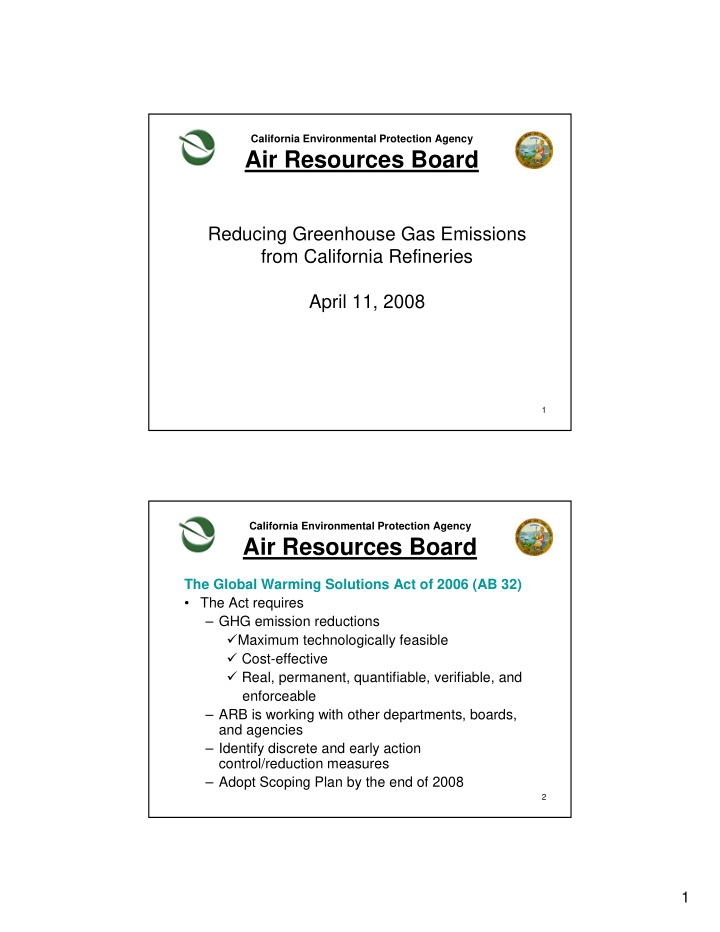



California Environmental Protection Agency Air Resources Board Reducing Greenhouse Gas Emissions from California Refineries April 11, 2008 1 California Environmental Protection Agency Air Resources Board The Global Warming Solutions Act of 2006 (AB 32) • The Act requires – GHG emission reductions � Maximum technologically feasible � Cost-effective � Real, permanent, quantifiable, verifiable, and enforceable – ARB is working with other departments, boards, and agencies – Identify discrete and early action control/reduction measures – Adopt Scoping Plan by the end of 2008 2 1
California Environmental Protection Agency Air Resources Board DRAFT Total 2004 CA Refinery GHG Emissions MMT CO2 eq. % of Total Emissions Process Heaters & Boilers 14 40% FCC catalyst regeneration (coke burn off) 6 18% Hydrogen Production 6 17% In-Process fuel use (e.g., natural gas & coke combustion) 5 13% Turbine Electric Cogeneration 3 9% Turbine Combustion IC reciprocating engines Industrial process miscellaneous combustion Incinerators 1 3% Asphalt heaters ICE electricity generation Flares 0.3 < 1% Fugitives 0.03 < 0.1% Total 35 100% Based on ARB GHG Inventory: http://www.arb.ca.gov/cc/inventory/doc/doc_index.php 3 California Environmental Protection Agency Air Resources Board DRAFT DRAFT Four Potential Control/Reduction Measures for Refining Sector - Reduce refinery fugitive emissions by removing methane exemption from existing regulations. - Develop and expand requirements to curtail flaring emissions at refineries. Example: BAAQMD Flare Minimization Plans operations (FMPs.). 4 2
California Environmental Protection Agency Air Resources Board DRAFT DRAFT Potential Measures (continued) - E stablish criteria for requirements to replace existing process heaters, boilers, and IC engines with electrification, and combined cycle cogeneration; recommend reduction of existing barriers (related to permitting) for expanding combined cycle cogeneration. - Develop a refinery cap and trade system; establish benchmarks for overall refinery efficiency or for specific refinery operations and criteria for refinery emissions trading system. 5 California Environmental Protection Agency Air Resources Board DRAFT DRAFT Reducing Refinery GHG Fugitive Emissions Potential GHG Reduction Fugitive Emission Sources Measure (MMT CO2 eq.) Removing Methane Storage Tanks Exemption 0.012 Removing Methane WW Treatment Exemption Up to 0.07 Process Losses (pumps, compressors, valves, connections Removing Methane 0.014 and other miscellaneous Exemption equipment) (1) Cooling Towers (2) Removing Methane Undetermined Exemption Measures Total 0.03 – 0.1 1) Existing Air District Rules require control of NMHC fugitive emissions; inclusion of methane could result in 80-90% reductions in methane emissions. 2) The EPA rule has proposed options to require a leak detection and repair program for cooling towers under section 112(d)(2) and (f)(2) 6 3
California Environmental Protection Agency Air Resources Board DRAFT DRAFT Reducing Flare GHG Emissions Potential GHG Measure Reduction (MMT CO 2 eq.) Replace with Gas Recovery (1) 0.20 1) Example is the BAAQMD FMPs (Flare Minimization Plans) 7 California Environmental Protection Agency Air Resources Board DRAFT DRAFT Reducing Process Heater & Boiler GHG Emissions Potential GHG Reduction Measure (1) (MMT CO 2 eq.) Replace low efficiency units with new 2.9 Replace with electrical heaters 3.5 (uses combined cycle cogeneration) Replace distillation with Membrane-Distillation hybrid 2.8 process (2) 1) - Energy Efficiency & Industrial Boiler Efficiency (CIBO http://cibo.org/pubs/whitepaper1.pdf); - BAAQMD Regulation 9, Rule 7: NOx and CO FROM INDUSTRIAL, INSTITUTIONAL, AND COMMERCIAL BOILERS, STEAM GENERATORS, AND PROCESS HEATERS, May 2007, (Bay Area Planning, Rules and Research Division) 2) Distillation accounts for nearly 40% of refinery’s energy use (US DOE). Membrane-Distillation hybrid process can reduce energy use by 20% http://www1.eere.energy.gov/industry/petroleum_refining/pdfs/separtech.pdf 8 4
California Environmental Protection Agency Air Resources Board DRAFT DRAFT Reducing FCC & Coke Combustion GHG Emissions Potential GHG Reduction Measure (MMT CO 2 eq.) Replace Coke Combustion FCC ������������������ 0.61 ����������� ��������������������������������������������� 0.61 ratio with CO boiler or incinerator ����������������������������������������������� 0.06 �������������������������� Heavy Oil slurry-Catalyst Technology (eliminates coke 0.61 byproduct but requires hydrogen plant) (1) 1) - Chevron Vacuum Resid Slurry Hydrocracking (VRSH) pre-commercial plant in Pascagoula, Miss 2010; - Eni Slurry Technology (Snamprogetti S.p.A., Eni Italy) recent agreement PDVSA, Venezuela 9 California Environmental Protection Agency Air Resources Board DRAFT DRAFT Reducing Turbine Combustion GHG Emissions Potential GHG Reduction Measure (1) (MMT CO2 eq.) Replace Single Cycle with Combined Cycle 0.46 Replace Single Cycle with Combined Cycle 0.80 Cogeneration 1) Council of Industrial Boiler Owners, http://cibo.org/pubs/whitepaper1.pdf 10 5
California Environmental Protection Agency Air Resources Board DRAFT DRAFT Reducing IC Engines, Miscellaneous Combustion, Incinerators, & Asphalt GHG Emissions Potential GHG Measure Reduction (MMT CO 2 eq.) Replace with Simple Cycle Turbine 0.13 Replace with Combined Cycle 0.40 Cogeneration 11 California Environmental Protection Agency Air Resources Board Contact Information DRAFT DRAFT Dean Simeroth John Courtis Chief, Criteria Pollutants Branch Manager, Alt. Fuels Section Phone: 916-322-6020 Phone: 916-323-2661 Email: dsimerot@arb.ca.gov Email: jcourtis@arb.ca.gov Tentative Schedule May 2008 Establish a working/advisory group May 2008 – June 2009 Workshops May 2008 – June 2009 Evaluation of benefits and costs of proposed measures June - 2008 Draft scoping plan November 2008 Board’s consideration of scoping plan June 2009 Draft measures November 2009 Board’s consideration of the measures January 2010 Implementation begins 12 6
Recommend
More recommend